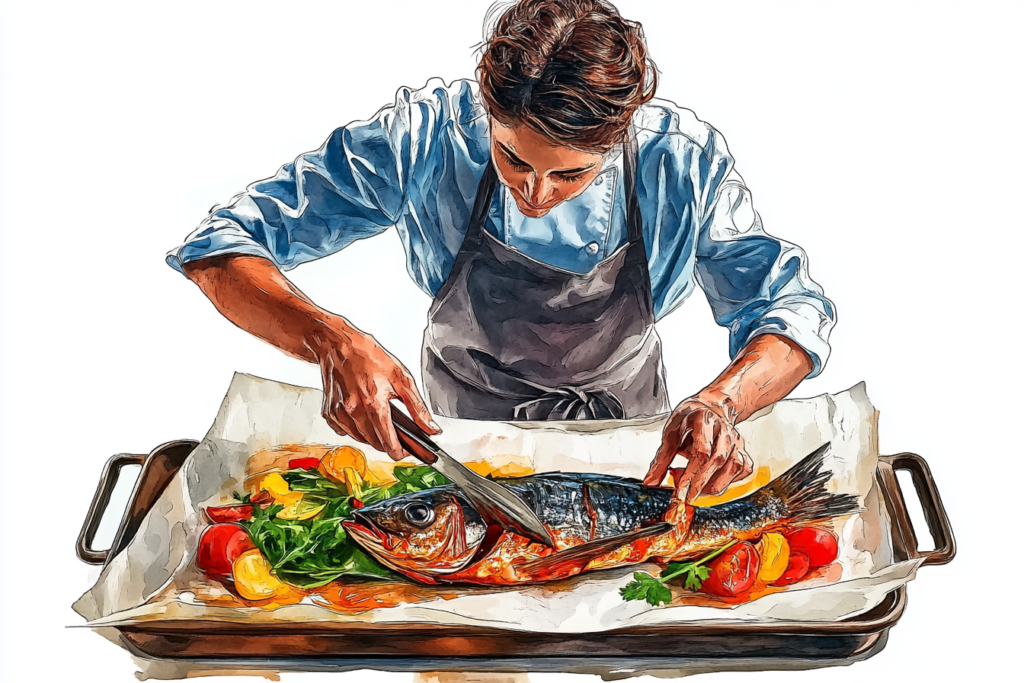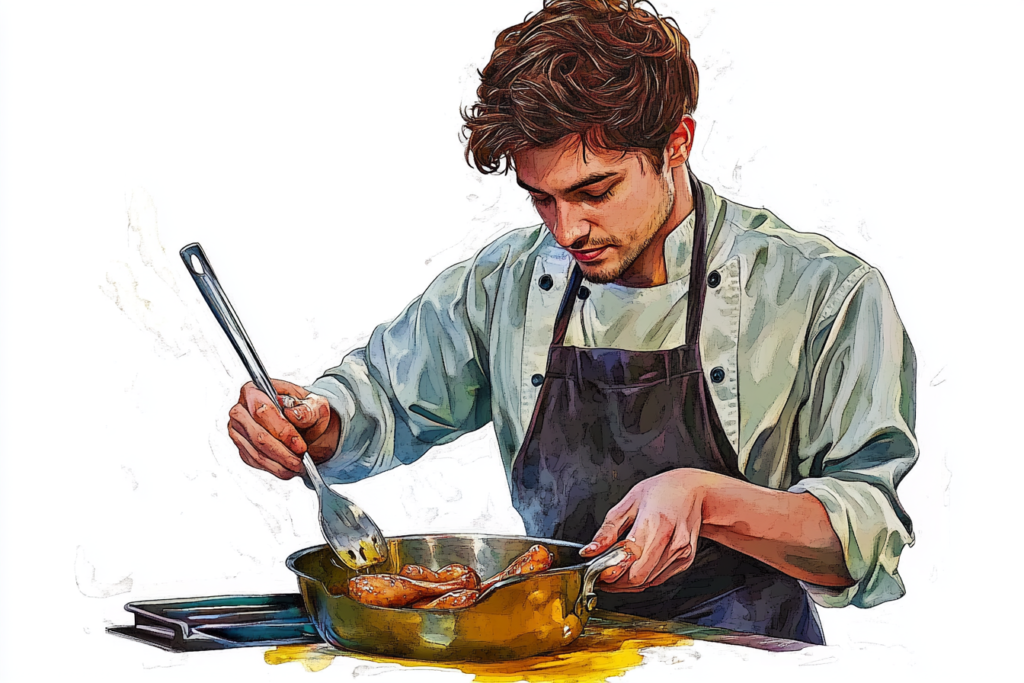French cooking has a branding problem. To the uninitiated, it’s the culinary equivalent of a black-tie gala—exclusive, fussy, and slightly intimidating. It’s the domain of toque-wearing chefs who speak in hushed tones about sous vide and confit, while the rest of us wonder if we’re even allowed to look at a shallot without a permit. But here’s the thing: French cooking isn’t about being fancy. It’s about being precise. It’s about respect. And yes, it’s about butter. But mostly, it’s about the kind of discipline that turns a humble carrot into a revelation.
Let’s start with the reputation. French cuisine is often dismissed as laborious and ostentatious, a culinary discipline that demands you spend three days making a stock only to reduce it to a single tablespoon of sauce. And sure, there’s some truth to that. French cooking doesn’t exactly lend itself to the “dump and stir” school of thought. But to reduce it to mere pretension is to miss the point entirely. French cooking is a compendium of thoroughly defined and described skills and techniques, a kind of culinary Rosetta Stone that unlocks the secrets of flavour, texture, and balance. It’s not about showing off; it’s about showing up.


 So why does French cooking have such a reputation for being laborious and ostentatious? Maybe it’s because we live in a world that values speed over skill, convenience over craftsmanship. Maybe it’s because we’ve forgotten that cooking isn’t just about feeding ourselves; it’s about nourishing our souls. Or maybe it’s because we’re intimidated by the idea of doing something well, of taking the time to learn and practice and perfect.
But here’s the thing: French cooking isn’t about being perfect. It’s about being present and respecting the ingredients, honouring the process, and savouring the results. It’s about understanding that a meal isn’t just a meal; it’s an experience, a celebration, a labour of love. And if that’s pretentious, then maybe we could all use a little more pretension in our lives.
So why does French cooking have such a reputation for being laborious and ostentatious? Maybe it’s because we live in a world that values speed over skill, convenience over craftsmanship. Maybe it’s because we’ve forgotten that cooking isn’t just about feeding ourselves; it’s about nourishing our souls. Or maybe it’s because we’re intimidated by the idea of doing something well, of taking the time to learn and practice and perfect.
But here’s the thing: French cooking isn’t about being perfect. It’s about being present and respecting the ingredients, honouring the process, and savouring the results. It’s about understanding that a meal isn’t just a meal; it’s an experience, a celebration, a labour of love. And if that’s pretentious, then maybe we could all use a little more pretension in our lives.


Mise en Place: The Foundation of Flavour
Take mise en place, for example. This is the French practice of preparing and organizing all your ingredients before you start cooking. It’s not just a fancy phrase; it’s a philosophy. It’s the culinary equivalent of putting on your big-kid pants and getting your life together before you attempt to do anything remotely ambitious. And yet, somehow, this simple act of preparation has been twisted into a symbol of French pretension. Why? Because it requires effort? Because it demands a level of forethought that goes beyond “I guess I’ll just wing it”? Please. Mise en place isn’t pretentious; it’s practical. It’s the difference between a chaotic kitchen disaster and a smoothly executed meal. It’s the difference between you crying over a burnt roux and calmly sipping wine while your coq au vin simmers to perfection.The Precision of Knife Work
And then there are the knife skills. Oh, the knife skills. French cooking demands precision, and nowhere is this more evident than in the way it treats its vegetables. A julienne cut isn’t just a thin strip of carrot; it’s a commitment to uniformity, to ensuring that every piece cooks evenly and harmonizes with the rest of the dish. A chiffonade isn’t just a pile of shredded basil; it’s a delicate ribbon that releases its aroma and flavour in just the right way. These techniques aren’t about showing off; they’re about respecting the ingredients. They’re about understanding that a carrot isn’t just a carrot—it’s a potential masterpiece if only you take the time to treat it right.Sautéing: A Global Staple
But let’s not stop there. Let’s talk about sautéing, that glorious dance of high heat and quick movements. The French didn’t invent sautéing, but they certainly perfected it. It’s a technique that’s as universal as it is versatile, used in everything from Italian risottos to Thai stir-fries. And yet, somehow, it’s been co-opted into the narrative of French pretension. Why? Because it requires attention? Because it demands that you stand over the stove and actually cook? Heaven forbid.Braising: Slow and Steady Wins the Flavour Race
And then there’s braising, the slow, gentle cooking method that turns tough cuts of meat into tender, flavorful masterpieces. Yes, the French use it for coq au vin and boeuf bourguignon, but it’s not like they’re hoarding the technique for themselves. Braising is a global phenomenon, used in Indian dals, Mexican birria, and Jewish brisket. It’s a technique that transcends borders and cuisines, and yet it’s often lumped in with the rest of French cooking’s “fancy” reputation. Why? Because it takes time? Because it requires patience and care? Again, please.Confit: Preservation Meets Indulgence
Even confit, that indulgent method of cooking meat in its own fat, gets a bad rap. Yes, it’s rich. Yes, it’s decadent. But it’s also a preservation technique, born out of necessity rather than extravagance. The French didn’t invent confit to show off; they invented it to survive. And yet, somehow, it’s become a symbol of culinary excess. Why? Because it’s delicious? Because it’s a reminder that sometimes, the best things in life are worth the effort? Guilty as charged. It’s a reminder that French culinary arts are as much about innovation as tradition.En Papillote: Cooking with Steam and Style
En papillote, or “in paper,” is a cooking fundamental that uses parchment or foil. This method traps steam, gently cooking proteins and vegetables to perfection. While it’s a staple in French kitchens, this technique also shines in dishes like Kerala’s Meen Pollichattu and Bengal’s Macher Paturi. It’s an elegant example of how French cooking techniques resonate across cultures.Flambéing: A Dramatic Finale
Few culinary methods are as theatrical as flambéing, where alcohol is ignited to create a burst of flavour. From the French Crêpes Suzette to the American Bananas Foster, this technique adds a touch of drama to desserts. It proves that French culinary arts are as much about spectacle as they are about taste. So why does French cooking have such a reputation for being laborious and ostentatious? Maybe it’s because we live in a world that values speed over skill, convenience over craftsmanship. Maybe it’s because we’ve forgotten that cooking isn’t just about feeding ourselves; it’s about nourishing our souls. Or maybe it’s because we’re intimidated by the idea of doing something well, of taking the time to learn and practice and perfect.
But here’s the thing: French cooking isn’t about being perfect. It’s about being present and respecting the ingredients, honouring the process, and savouring the results. It’s about understanding that a meal isn’t just a meal; it’s an experience, a celebration, a labour of love. And if that’s pretentious, then maybe we could all use a little more pretension in our lives.
So why does French cooking have such a reputation for being laborious and ostentatious? Maybe it’s because we live in a world that values speed over skill, convenience over craftsmanship. Maybe it’s because we’ve forgotten that cooking isn’t just about feeding ourselves; it’s about nourishing our souls. Or maybe it’s because we’re intimidated by the idea of doing something well, of taking the time to learn and practice and perfect.
But here’s the thing: French cooking isn’t about being perfect. It’s about being present and respecting the ingredients, honouring the process, and savouring the results. It’s about understanding that a meal isn’t just a meal; it’s an experience, a celebration, a labour of love. And if that’s pretentious, then maybe we could all use a little more pretension in our lives.






